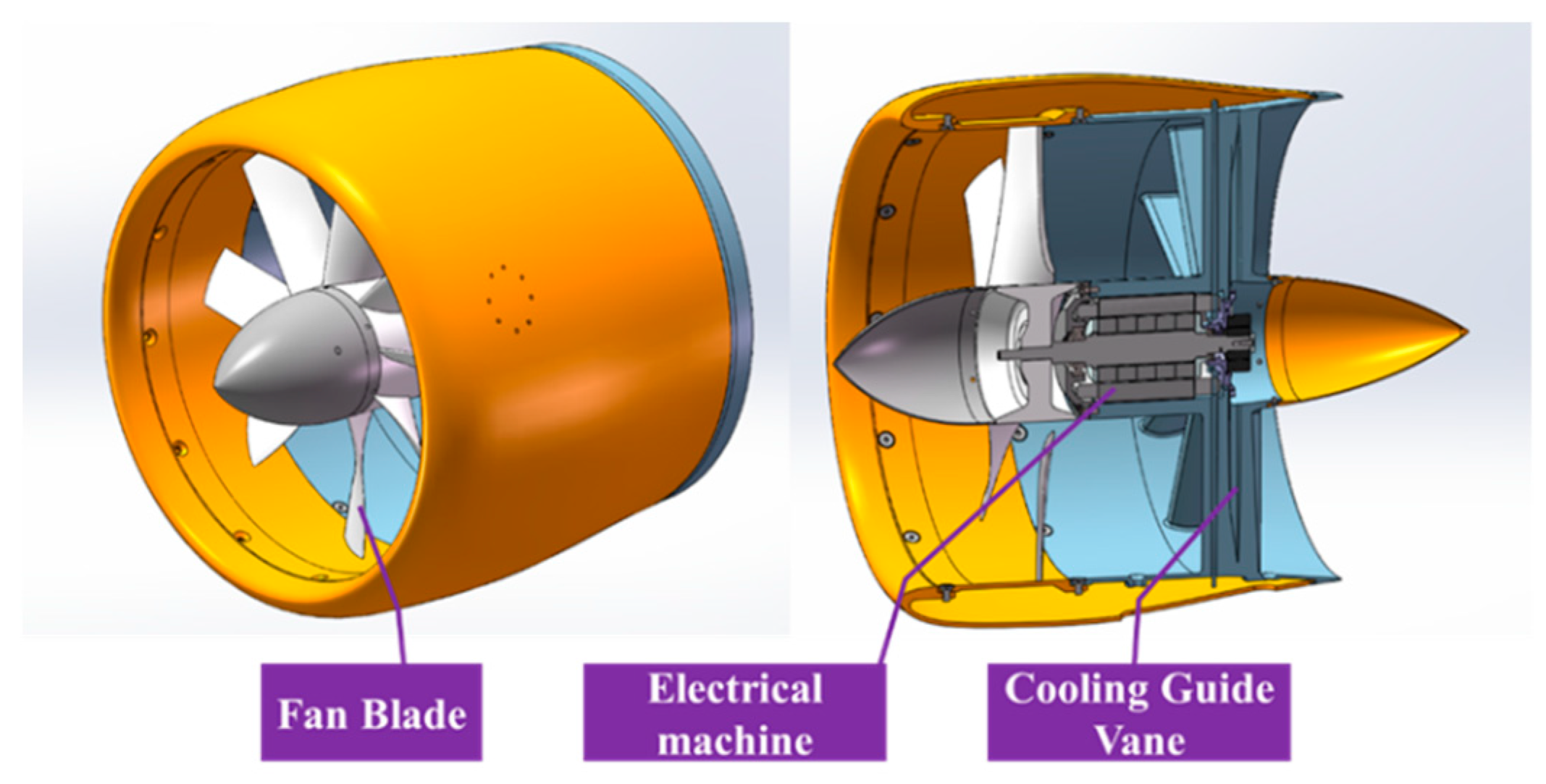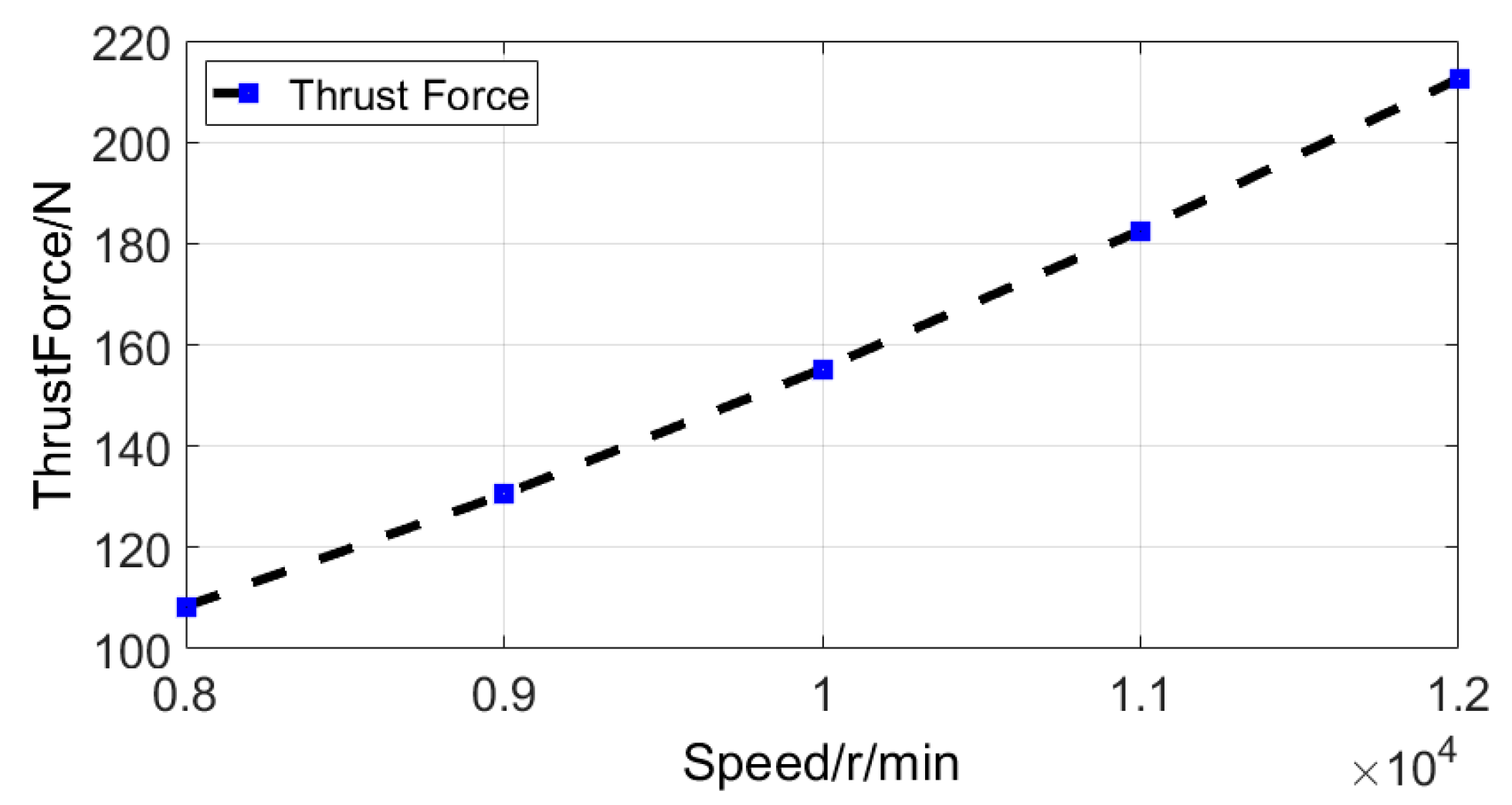Thermal Benefits of a Cooling Guide Vane for an Electrical Machine in an Electric Ducted Fan
Abstract
:1. Introduction
2. Proposed Cooling Guide Vane with a Heat Pipe for an Electrical Machine in an EDF
Electrical Machine Used in an EDF
- (1)
- Winding: a concentrated winding wound around one stator tooth, which has a higher slot fill factor, and a short end winding. The space between the two adjacent tooth coils is beneficial for the installation of the heat pipe.
- (2)
- Rotor: the magnet flux concentration topology enables a higher air gap flux density, which is beneficial for a higher power density.
- (3)
- Torque: the low cogging torque and torque ripple caused by the 10/12 slot/pole combination ensures the smooth operation of the fan blades with low vibrations.
3. Preliminary Design of the CGVHP
3.1. CGVHP Cooling System Design
3.2. Cooling Guide Vane
3.3. Heat Pipe Utilization and Modeling
4. Thermal Modeling of the CGVHP
4.1. CFD Model
4.2. Electrical Machine Losses
4.3. Cooling Guide Vane
5. Results and Discussion
6. Conclusions
Author Contributions
Funding
Institutional Review Board Statement
Informed Consent Statement
Data Availability Statement
Conflicts of Interest
References
- Garrow, L.A.; German, B.J.; Leonard, C.E. Urban air mobility: A comprehensive review and comparative analysis with autonomous and electric ground transportation for informing future research. Transp. Res. Part C Emerg. Technol. 2021, 132, 103377. [Google Scholar] [CrossRef]
- Rajendran, S.; Srinivas, S. Air taxi service for urban mobility: A critical review of recent developments, future challenges, and opportunities. Transp. Res. Part E Logist. Transp. Rev. 2020, 143, 102090. [Google Scholar] [CrossRef]
- Morgan, S. Flying Cars: Investment Implications of Autonomous Urban Airmobility; Morgan Stanley: New York, NY, USA, 2018. [Google Scholar]
- Baur, S.; Schickram, S.; Homulenko, A.; Martinez, N.; Dyskin, A. Urban air mobility: The rise of a new mode of transportation. Available online: https://www.rolandberger.com/publications/publication_pdf/Roland_Berger_Urban_Air_Mobility.pdf (accessed on 3 October 2022).
- Brown, K.A.; Fleming, J.L.; Langford, M.; Ng, W.; Schwartz, K.; Combs, C. Development of a Ducted Propulsor for BLI Electric Regional Aircraft—Part I: Aerodynamic Design and Analysis. In Proceedings of the AIAA Propulsion and Energy 2019 Forum, Indianapolis, IN, USA, 19–22 August 2019. [Google Scholar]
- Zhang, T.; Barakos, G. Review on ducted fans for compound rotorcraft. Aeronaut. J. 2020, 124, 941–974. [Google Scholar] [CrossRef]
- Zong, J.; Zhu, B.; Hou, Z.; Yang, X.; Zhai, J. Evaluation and Comparison of Hybrid Wing VTOL UAV with Four Different Electric Propulsion Systems. Aerospace 2021, 8, 256. [Google Scholar] [CrossRef]
- Technology Blog. 2022. Available online: https://lilium.com/newsroom-detail/technology-behind-the-lilium-jet (accessed on 4 October 2022).
- RWTH-Acchen, I. Silent Propulsors for Air Taxis. Available online: https://www.ist.rwth-aachen.de/cms/IST/Forschung/Research-areas/~nzmau/Silent-propulsors-for-air-taxis/lidx/1/ (accessed on 4 October 2022).
- About e.SAT. 2022. Available online: https://e-sat.de/en/about-e.sat/ (accessed on 4 October 2022).
- Sayed, E.; Abdalmagid, M.; Pietrini, G.; Sa’adeh, N.M.; Callegaro, A.D.; Goldstein, C.; Emadi, A. Review of Electric Machines in More-/Hybrid-/Turbo-Electric Aircraft. IEEE Trans. Trans. Electr. 2021, 7, 2976–3005. [Google Scholar] [CrossRef]
- El-Refaie, A.; Osama, M. High specific power electrical machines: A system perspective. CES Trans. Electr. Mach. Syst. 2019, 3, 88–93. [Google Scholar] [CrossRef]
- Hebala, A.; Nuzzo, S.; Connor, P.H.; Giangrande, P.; Gerada, C.; Galea, M. Improved Propulsion Motor Design for a Twelve Passenger All-Electric Aircraft. In Proceedings of the 2021 IEEE Workshop on Electrical Machines Design, Control and Diagnosis (WEMDCD), Modena, Italy, 8–9 April 2021; pp. 343–348. [Google Scholar] [CrossRef]
- Vannini, A.; Marfoli, A.; Papini, L.; Bolognesi, P.; Gerada, C. Materials for Electric Machines Suited for High-Temperature Applications: A Survey. In Proceedings of the 2021 IEEE Workshop on Electrical Machines Design, Control and Diagnosis (WEMDCD), Modena, Italy, 8–9 April 2021; pp. 101–106. [Google Scholar] [CrossRef]
- Dong, C.; Qian, Y.; Zhang, Y.; Zhuge, W. A Review of Thermal Designs for Improving Power Density in Electrical Machines. IEEE Trans. Transp. Electrif. 2020, 6, 1386–1400. [Google Scholar] [CrossRef]
- Meng, T.; Zhang, P. A Review of Thermal Monitoring Techniques for Radial Permanent Magnet Machines. Machines 2021, 10, 18. [Google Scholar] [CrossRef]
- Jin, Y.; Qian, Y.; Zhang, Y.; Zhuge, W. Modeling of Ducted-Fan and Motor in an Electric Aircraft and a Preliminary Integrated Design. SAE Int. J. Aerosp. 2018, 11, 115–126. [Google Scholar] [CrossRef]
- Yi, X.; Sanchez, R.; Haran, K.; Veres, J.; Perry, A.T.; Ansell, P.J. Self-Pumped Air-Cooling Design for a High-Speed High-Specific-Power Motor. In Proceedings of the 2018 IEEE Transportation Electrification Conference and Expo (ITEC), Long Beach, CA, USA, 13–15 June 2018. [Google Scholar]
- Yoon, A.K.; Xiao, J.; Lohan, D.; Arastu, F.; Haran, K.S. High-Frequency Electric Machines for Boundary Layer Ingestion Fan Propulsor. IEEE Trans. Energy Convers. 2019, 34, 2189–2197. [Google Scholar] [CrossRef]
- Yu, Z.; Li, Y.; Jing, Y.; Wang, J. Cooling System of Outer Rotor SPMSM for a Two-Seater All-Electric Aircraft Based on Heat Pipe Technology. IEEE Trans. Transp. Electrif. 2021, 8, 1656–1664. [Google Scholar] [CrossRef]
- Le, W.; Lin, M.; Lin, K.; Liu, K.; Jia, L.; Yang, A.; Wang, S. A Novel Stator Cooling Structure for Yokeless and Segmented Armature Axial Flux Machine with Heat Pipe. Energies 2021, 14, 5717. [Google Scholar] [CrossRef]
- Geng, W.; Zhu, T.; Li, Q.; Zhang, Z. Windings Indirect Liquid Cooling Method for a Compact Outer-Rotor PM Starter/Generator With Concentrated Windings. IEEE Trans. Energy Convers. 2021, 36, 3282–3293. [Google Scholar] [CrossRef]
- Masson, P.J.; Pienkos, J.E.; Luongo, C.A. Scaling Up of HTS Motor Based on Trapped Flux and Flux Concentration for Large Aircraft Propulsion. IEEE Trans. Appl. Supercond. 2007, 17, 1579–1582. [Google Scholar] [CrossRef]
- Moon, S.-H.; Hwang, G.; Kim, S.-J.; Seo, J.-K. Thermal Analysis and Testing of a Heat Pipe With Woven Wired Wick. IEEE Trans. Compon. Packag. Manuf. Technol. 2014, 4, 991–998. [Google Scholar] [CrossRef]
- Hu, X.; Guo, H.; Qian, H.; Ding, X.; Yang, Y. Development of a high-power-density motor for formula SAE electric race car. In Proceedings of the IECON 2017-43rd Annual Conference of the IEEE Industrial Electronics Society, Beijing, China, 29 October–1 November 2017; pp. 6618–6622. [Google Scholar] [CrossRef]
- Putra, N.; Ariantara, B. Electric motor thermal management system using L-shaped flat heat pipes. Appl. Therm. Eng. 2017, 126, 1156–1163. [Google Scholar] [CrossRef]
- Dong, C.; Qian, Y.; Zhang, Y.; Hu, X.; Zhuge, W. Coupled Thermal-Electromagnetic Parametric Modeling of Permanent Magnet Machine Based on Flat Heat Pipe Cooling. In Proceedings of the 2020 23rd International Conference on Electrical Machines and Systems (ICEMS), Hamamatsu, Japan, 24–27 November 2020. [Google Scholar] [CrossRef]
- Huang, J.; Naini, S.S.; Miller, R.; Rizzo, D.; Sebeck, K.; Shurin, S.; Wagner, J. A Hybrid Electric Vehicle Motor Cooling System—Design, Model, and Control. IEEE Trans. Veh. Technol. 2019, 68, 4467–4478. [Google Scholar] [CrossRef]
- Liu, F.; Lan, F.; Chen, J. Dynamic thermal characteristics of heat pipe via segmented thermal resistance model for electric vehicle battery cooling. J. Power Sources 2016, 321, 57–70. [Google Scholar] [CrossRef]
- Greco, A.; Cao, D.; Jiang, X.; Yang, H. A theoretical and computational study of lithium-ion battery thermal management for electric vehicles using heat pipes. J. Power Sources 2014, 257, 344–355. [Google Scholar] [CrossRef]
- Simpson, N.; Wrobel, R.; Mellor, P.H. Estimation of Equivalent Thermal Parameters of Impregnated Electrical Windings. IEEE Trans. Ind. Appl. 2013, 49, 2505–2515. [Google Scholar] [CrossRef]




















| Item | Value | Item | Value |
|---|---|---|---|
| Thrust Force | 220 N | Fan Diameter | 300 mm |
| Hub-to-tip Ratio | 0.3 | Speed | 12,000 RPM |
| Number of Fan Blades | 8 | Number of CGVHP | 12 |
| Electrical Machine | PMSM | ||
|---|---|---|---|
| Peak Torque | 12.5 Nm | Peak Speed | 12,000 RPM |
| Number of Stator Slots | 12 | Insulation Class | 120 °C |
| Efficiency | 95% | Phase Resistance | 80 mΩ (25 °C) |
| Stator Outer Diameter | 75 mm | Stator Inner Diameter | 45 mm |
| Stack Length | 60 mm | Active mass | 1.764 kg |
| Stator mass | 1.081 kg | Rotor mass | 0.683 kg |
| Material | Thermal Conductivity (W/mK) |
|---|---|
| Ceramic | 360 |
| Copper | 385 |
| Graphene | 3000~3500 |
| Heat Pipe | Up to 104 |
| Material | Thermal Conductivity (W/mK) | Density (kg/m3) | Specific Heat Capacity (J/kg) |
|---|---|---|---|
| Air (25 °C) | 0.026 | 1.27 | 1005 |
| Aluminum Alloy | 160 | 2750 | 890 |
| Heat Pipe | 0–4000 | 7560 | 380 |
| Stator Lamination | Axial: 5.5 Radial and tangential: 27 | 460 | 7650 |
| Slot Insulation | 0.14 | 1400 | 1300 |
| Winding | Axial: 219 Radial and tangential: 3.3 | 4600 | 1500 |
Publisher’s Note: MDPI stays neutral with regard to jurisdictional claims in published maps and institutional affiliations. |
© 2022 by the authors. Licensee MDPI, Basel, Switzerland. This article is an open access article distributed under the terms and conditions of the Creative Commons Attribution (CC BY) license (https://creativecommons.org/licenses/by/4.0/).
Share and Cite
Hu, X.; Qian, Y.; Dong, C.; Zhang, Y.; Wang, C.; Zhuge, W. Thermal Benefits of a Cooling Guide Vane for an Electrical Machine in an Electric Ducted Fan. Aerospace 2022, 9, 583. https://doi.org/10.3390/aerospace9100583
Hu X, Qian Y, Dong C, Zhang Y, Wang C, Zhuge W. Thermal Benefits of a Cooling Guide Vane for an Electrical Machine in an Electric Ducted Fan. Aerospace. 2022; 9(10):583. https://doi.org/10.3390/aerospace9100583
Chicago/Turabian StyleHu, Xuanyang, Yuping Qian, Chaofan Dong, Yangjun Zhang, Changjiang Wang, and Weilin Zhuge. 2022. "Thermal Benefits of a Cooling Guide Vane for an Electrical Machine in an Electric Ducted Fan" Aerospace 9, no. 10: 583. https://doi.org/10.3390/aerospace9100583




